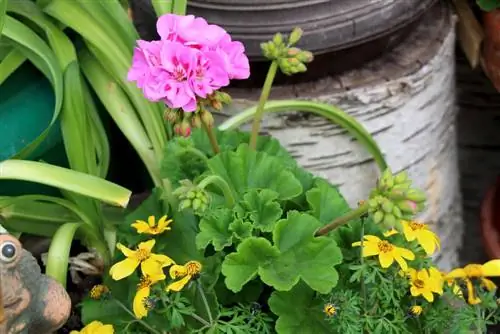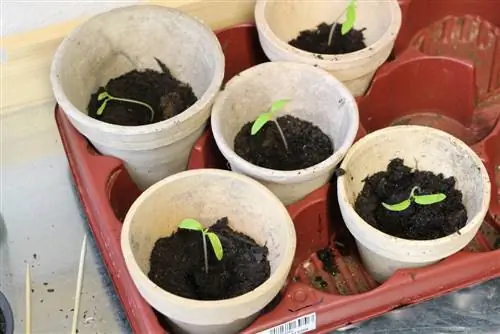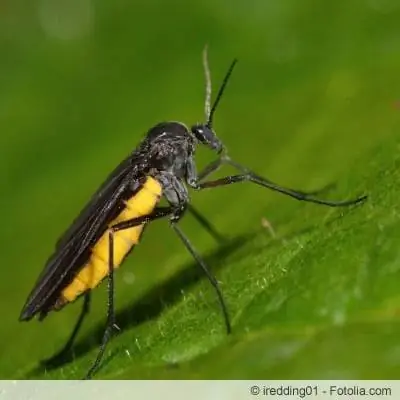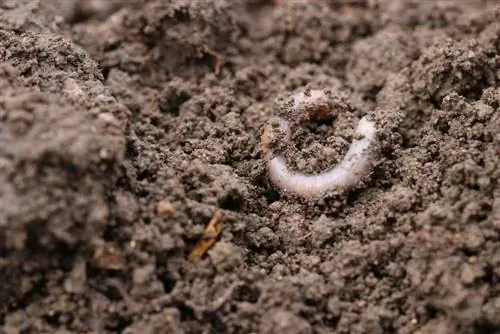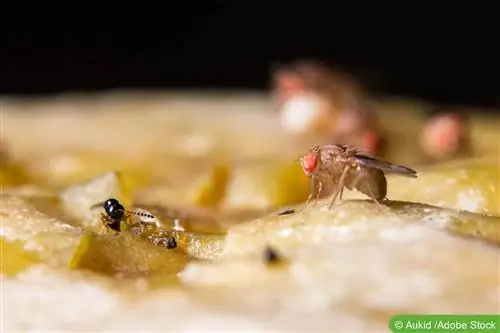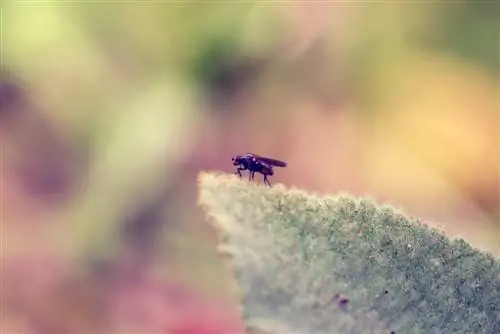- Author admin [email protected].
- Public 2023-12-17 03:39.
- Last modified 2025-01-24 12:45.
Adult fungus gnats are quite easy to control. Things get more difficult with the larvae, especially if you don't want to use chemical agents. What you need to know about preventing and combating fungus gnats can be found in the following text.
malicious image
You can see grey-brown, 3 to 4 mm large, narrow midges that crawl over the surface of the soil in the flower pot. However, they also fly around and settle slowly and gently on leaves. They resemble fruit flies. Each female lays between 100 and 200 eggs, from which the larvae hatch after just a week. These are up to 5 mm long, maggot-shaped, whitish in color and have a black head. They live in the soil and can damage the plant. The plants are weakening. You can't really find a cause, except for the small flying insects.
Prevention
Prevention is difficult and even if it is successful, an infestation cannot be ruled out. The pests are often introduced when purchasing a new plant or with fresh potting soil. It makes no difference whether you buy cheap or expensive soil. The eggs are even in organic soil, which is because the different types of fungus gnats are quite useful. They are therefore particularly common in organic farms. The mosquitoes like to settle when the plants are outdoors in summer. However, it doesn't do much good to leave them in the room, because fungus gnats also get into rooms through open windows. They are hardly noticed individually, but when they have multiplied and appear in masses, they become a nuisance because they don't just stay on the plants, they fly around everywhere.
It is important not to keep the houseplants too moist. The top layer of soil must not be constantly moist. Fungus gnats love things like that. As a preventive measure, the earth can therefore be covered with sand, small stones, small shells or similar materials. The sand layer should be about 1 cm thick. Quartz sand is particularly suitable.
Tip:
Planters with irrigation systems are convenient for plants that need some moist soil. Once established, the plants draw the water they need from the reservoir from below, the upper layer of soil hardly ever comes into contact with water and stays nice and dry.
It is also helpful to treat new potting soil with heat in the microwave or in the stove. Insect eggs are killed. Depending on the amount and wattage of the microwave, the earth should be heated for 2 to 5 minutes. The soil is spread on a tray in the oven and heated at 100 degrees for about half an hour. This kills larvae, regardless of the species.
It is even better, however, to no longer use soil in the usual sense. With hydroponics you avoid fungus gnats, at least to a large extent. Not all plants are suitable for this, but there are a lot. Regardless of whether seramis, gravel, perlite or other mineral substrates are used, fungus gnats cannot multiply in them. The condition is that all potting soil was removed when repotting. Dead root parts and dead organic material must also be removed.
It can also help not to water the plants in potting soil from above, but always from below, i.e. into the planter or a saucer. However, excess water should be poured off about 30 minutes after watering.
Fighting adult fungus gnats
Adult fungus gnats are quite easy to control. They like strong colors, especially yellow. That's why non-toxic yellow stickers or yellow boards help. You put them in the soil of the infected flower pot or place them in the immediate vicinity. The mosquitoes sit on the sticky surface and can't get away. If there is a heavy infestation, the stickers should be changed every now and then, whenever they are almost full and there is not much room left for new pests. It is important to leave the stickers or boards in place for weeks so that the next generation can remove them. If there is a heavy infestation, the mosquitoes can also be sucked out with a vacuum cleaner. Control is important so that no eggs are laid and new generations grow up.
Fighting fungus gnat larvae
The larvae can be fought in different ways. From old home remedies to chemical insecticides, there are numerous options. Sometimes you have to try several, not everything has an effect.
Home remedies
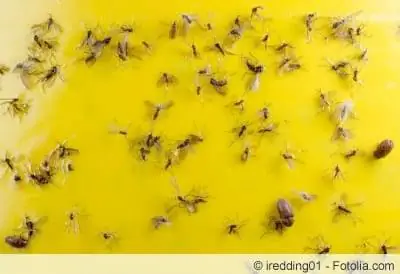
The match trick is an old one, but it usually works quite well. Simply stick a few matches upside down into the plant soil. There are sulfur components in the ignition head, which kill the larvae in the soil. However, the matches must be replaced after a few days. In addition, you have to keep the soil drier. A good layer of sand on the ground is also useful, as it prevents adult animals from continuing to lay eggs.
A mixture of lukewarm water, baking powder, a little oil and a little s alt is also helpful. This mixture is sprayed directly onto the affected soil. The flies then no longer dare to approach the containers.
Against the adults and larvae, it helps to completely close the potting soil for 4 to 5 weeks. The best way to do this is to put the entire flower pot in a nylon stocking and close it tightly. The water drainage holes must also be closed. This means that no flies come to the ground to lay eggs and no newly hatched larvae come out of the ground. Since a cycle lasts 4 to 5 weeks, you should rest afterwards.
Coffee grounds and Co
Distributing coffee grounds evenly over the surface of the potting soil has also proven to be extremely effective in the past. Another extremely effective trick is to place matches (upside down) in the ground.
After just two to three days, the infestation with the little pests is a thing of the past. The use of fruit fly traps in particular has always been very popular. A special fruit fly cocktail (a mixture of organic acids and fruit juice) is poured into the fly trap, whereupon the small insects are attracted and crawl in.
The special design of the fruit fly trap makes it impossible for the flies to fly out or crawl out. This means the end of the little flies.
Parasitic Nematodes
Nematodes are small roundworms, tiny, barely noticeable to the eye. They are placed into the soil with the irrigation water. There they act as parasites and attack the larvae of the fungus gnat and kill them. Nematodes are harmless to humans and animals. You can order hundreds of thousands of these nematodes by mail order. They are now also offered in plant markets, but only by order. It usually takes 2 to 3 weeks for the problem to be resolved. Steinernema feltiae are the most suitable. If the infestation is severe, the treatment should be repeated after about 4 weeks. It is important that the treatment is not carried out in sunshine because nematodes are sensitive to light. In addition, the substrate must not dry out during the treatment period, i.e. approx. 4 weeks, otherwise the nematodes will die. The earth shouldn't be too wet either.
Bacteria
Microorganisms, especially bacteria, can be valuable helpers in the fight against fungus gnats. The bacterium Bacillus thuringiensis var. israelensis (BTI) forms permanent spores with protein crystals, which are toxic to the larvae of the fungus gnat. The bacteria can be acquired like nematodes and they can also be added to irrigation water. They are absolutely harmless, except for the larvae.
Predatory mites (Hypoaspis miles)
Predatory mites feed on the larvae of the fungus gnat. Their use in greenhouses and closed winter gardens is particularly advantageous. Predatory mites live in the upper layers of the soil. There they hunt the larvae and eat them. This usually goes on until there are no more. Even then, the predatory mites can still exist for a few weeks.
Chemistry
especially desperate plant lovers use a mosquito repellent that is used in ponds and other stagnant bodies of water. Adding this to the irrigation water kills the pests. There are also biological products, you have to take a closer look when buying.
Chemistry should alwaysonly be used in emergencies. There are different insecticides available commercially. You should get advice about which ones are currently up to date. Every year funds are withdrawn from the market and new ones are used. Hopefully specialists are familiar with the advantages and disadvantages, otherwise you have to compare yourself. It is important to adhere to the manufacturer's instructions when dosing.
Sickness gnat infestations are usually just unpleasant and not particularly dangerous for plants, unless they are young plants, seedlings or cuttings. It is important to eliminate the fungus gnats themselves and especially the larvae. Yellow stickers are very helpful. In addition, the planting substrate should be kept drier and sprinkled with a layer of sand. If all else fails, nematodes, bacteria or predatory mites are a good biological control measure.

